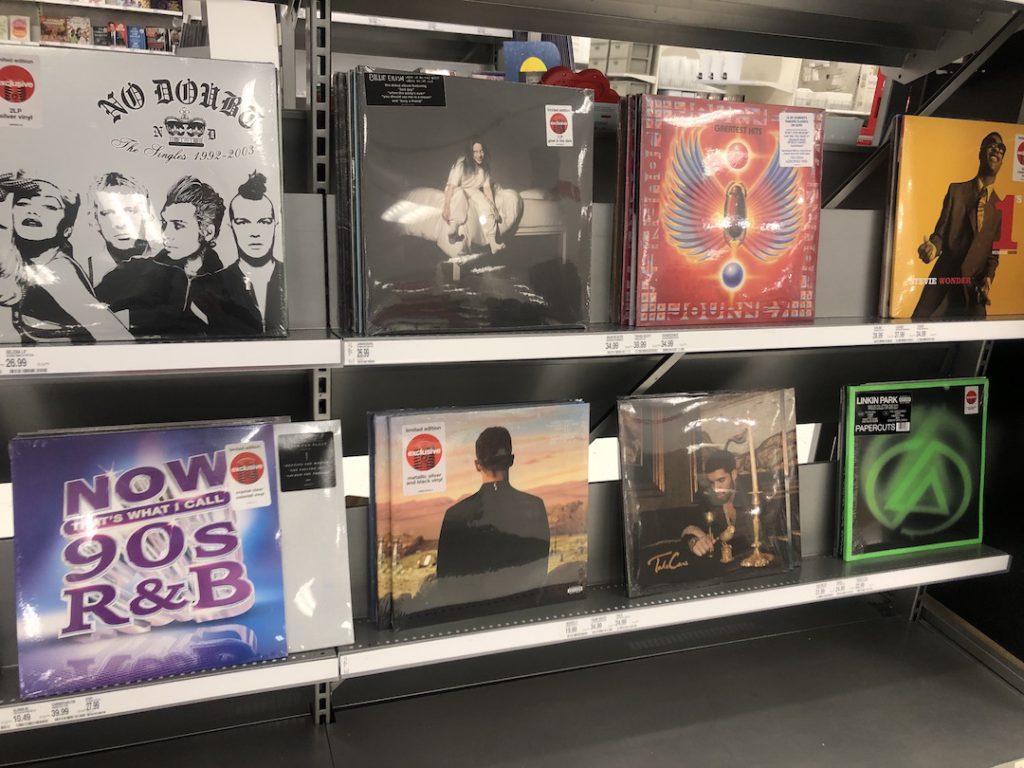
My eyes darted back and forth between two items on a sparsely populated shelf of records at the downtown Los Angeles Target. I couldn’t decide which one was more offensive. Was it the new vinyl reissue of a 15-year-old Celine Dion greatest hits collection? Or, was it the copy of Now That’s What I Call 90s R & B with the sticker that read “limited edition” and “exclusive”?
Target’s music selection has always sucked. Today, however, it sucks in a way that’s a lot like gentrification. It helps bolster the sales of the music industry’s 1% by selling exclusivity and collectibility to fans inside big box stores, an irony that I still can’t quite wrap my head around.
If you’re into records, then you know that this has been going on for a good while and that the so-called “vinyl boom” has come at the expense of indie and DIY artists. I touched on this in an article for Southern California News Group about Onyx Press Records (click here for a gift link to the story), a new manufacturer that launched, in part, because of the owners’ frustration with making records in a timely fashion. When listeners switched to CDs and then MP3s, vinyl remained popular within niche music communities. Once vinyl regained popularity, major labels swooped in to drop crap like Record Store Day reissues of $1 bin staples. Meanwhile, the class of artists that never abandoned vinyl— likely the same class that gets screwed hardest by Spotify and must endlessly tour and sell merch to survive— struggled to get new music out on the format.
That brings us to the post-gentrification part of vinyl’s story, where mega-corporations, investment groups and other assorted vultures don’t even pretend to consider who the end user might be. No one, not even Celine Dion fans on a ‘90s nostalgia kick, needs the Titanic theme on vinyl. It’s peak CD content. But, at least this anachronistic gimmick didn’t have an “exclusive” tag, unlike the Now That’s What I Call… compilation. Sticking “exclusive” and “limited edition” on the cover of what should be an impulse purchase at the checkout line is laughable. It’s like a “luxury” apartment with Home Depot interiors and a view of the 101. These words are no more than empty qualifiers tacked onto things that cost more than they should.
Then I stumbled upon racks dedicated to the World’s Most Boring Pop Star. Last month, when her latest album dropped, one outlet— I kid you not— gushed about how there was a secret second album in there, like it was an innovation of her own design and a gift to fans. It’s called a double album. Lots of bands have done it. Just like lots of artists have re-recorded their own songs when they don’t own the masters of the original. Clearly, these artists also don’t have marketing teams that excel in bullshitting Millennials who have spent the past 20 years listening to digital music on playlists.
Usually, a double album costs a little more than a standard one. The one from World’s Most Boring Pop Star, however, is $45.99, which is roughly $20 more than what you can expect to spend on a new record these days. “But, it’s 31 songs!” you might respond. Yeah, and it’s also $8 more than a brand new vinyl reissue of Sandinista, The Clash’s classic triple-vinyl album with 36 songs, on Target’s website.
But, her fans will spend a lot of money, reporters say in what passes for music journalism right now. They collect variants as if they are Pokémon, or so I gathered from a New York Times article. When I look around this section at Target, though, I have trouble believing the hype. There is a stack of 15 new records, which I counted because it’s pretty weird to see that many sealed copies of a month-old album in any store. There are also some CDs scattered around and another rack with vinyl copies of older releases.
It’s quite possible that I’m overly cynical, but 2020s life feels like wandering through a maze filled with smoke and mirrors. It’s becoming increasingly difficult to tell what is real and what isn’t. And I don’t believe these records were pressed for the benefit of people who love vinyl or are fans of the artist.
When neighborhoods are gentrified, it’s never about bettering the community for the people who live there. It’s about real estate. People speculate that a low-priced neighborhood is “up and coming,” so they buy with the goal of eventual profit. But, gentrification can backfire. You can end up with something like the graffiti towers situation a few blocks away from this Target or the “luxury” apartments that were bought by the city as homeless housing and are currently vacant. Meanwhile, your average Angeleno continues to pay more for a lower quality of life.
Similarly, these fresh vinyl reissues of the hits and new pop special releases are less about appeasing fans and more about appealing to those who truly believe that something marketed as a collectible is one. Maybe ask a ‘90s comic book fan about that.
So, what will it look like when the illusion of exclusivity and collectibility fades? Will corporations send their excess stock to join the mountains of fast fashion in the Atacama Desert? Will fans turn on their heroes and send records they never played to join Grandma and Grandpa’s Barbra Streisand castoffs in the garage? I don’t know the answer.
However, what I can say confidently is that we should all buy music in the format that is most accessible to us because we want to listen to it. None of us need to keep handing over money to billionaires because their marketing teams say that this will be valuable someday. That someday may never come.
Liz O. is an L.A.-based writer and DJ. Read her recently published work and check out her upcoming gigs.
Related:
